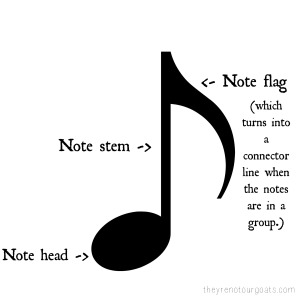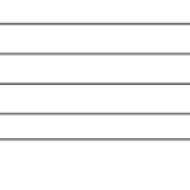
Welcome to 31 Days of Homemade Music! This month we are exploring how and why everyone can benefit from being an active participant in music making. To read more posts in this series, click here.
Perhaps you enjoyed goofing off with percussion a bit and decided that you would actually like to learn to read rhythms. If you plan to pursue music to any extent, you will eventually need to learn it, so let’s start by identifying the notes:
 (Thank you to Emily Clark Music for making this chart and many other music theory worksheets available for free download. I tend to only use the note value names on the left, but Emily also uses the British names, listed on the right.)
(Thank you to Emily Clark Music for making this chart and many other music theory worksheets available for free download. I tend to only use the note value names on the left, but Emily also uses the British names, listed on the right.)
Just FYI, Emily has her eighth and sixteenth notes shown in groups of two and four, respectively, for the sake of clearly seeing how a beat is divided. It should be noted that they can come in various other groupings, or they can come alone. The stems on a note can also go up or down, depending on where it sits on the staff. The important thing to pay attention to are the “flags” or lines at the end of the stem. Eighth notes always have one flag or line, sixteenth notes have 2 flags or lines, thirty-second notes always have three, and so on.
If you have no idea what “flag” or “stem” means, here’s an eighth note all by its lonesome just waiting to demonstrate for you:
So, as we can see in Emily’s chart, when we are in 4/4 time (you will find out what that means if you continue studying!), the quarter note gets the beat. That means that the whole note gets 4 beats, the half note gets 2 beats, the quarter note gets one, the eight note gets 1/2 beat, and the sixteenth note gets 1/4 of a beat. Think math with me here and it will all make sense.
Let’s practice. Pretend you’re about to march. Count off at a steady tempo: “1, 2, 3, 4! 1, 2, 3, 4!” etc. Each of those counts is now a beat. If the quarter note gets the beat, then each of these counts is one quarter note. Try clapping quarter notes while you count (one clap with each number.)
Now try clapping half notes. Since half notes will get two beats, You will only clap when you say “1” and “3.” Here’s what this would look like:
Clap ————- Clap————-
1 2 3 4
A whole note gets 4 beats, so you will only clap on “1” and hold it for four beats, like this:
Clap———————————–
1 2 3 4
Try eight notes. Remember that an eighth note only gets half a beat, so that means that you can fit two eighth notes into every beat. (Now the “clap” is represented by “C” for space’s sake.)
C C C C C C C C
1 2 3 4
And for fun, sixteenths- fitting four sixteenth notes into the space of one beat:
C C C C C C C C C C C C C C C C
1 2 3 4
Want to try some more? Vic Firth has a free progressive online course in reading and playing rhythms. Once you get the basic concepts, you can try the rhythm tool at Practice Sight Reading, or you can give the free Flash player-based Rhythm Trainer a try.
Rhythms are not just for percussion- they’re for every instrument! So tomorrow, I will give you a note reading 101 course in case you want to pursue playing something else. Enjoy counting in your head all day long… 😉


